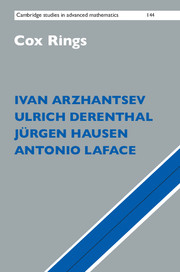2 - Toric varieties and Gale duality
Published online by Cambridge University Press: 05 October 2014
Summary
Toric varieties form an important class of examples in algebraic geometry, as they admit a complete description in terms of combinatorial data, so-called lattice fans. In Section 2.1, we briefly recall this description and also some of the basic facts in toric geometry. Then we present Cox's construction of the characteristic space of a toric variety in terms of a defining fan and discuss the basic geometry around this. Section 2.2 is pure combinatorics. We introduce the notion of a “bunch of cones” and show that, in an appropriate setting, this is the Gale dual version of a fan. Under this duality, the normal fans of polytopes correspond to bunches of cones arising canonically from the chambers of the so-called Gelfand–Kapranov–Zelevinsky decomposition. In Section 2.3, we discuss the geometric meaning of bunches of cones: they encode the maximal separated good quotients for subgroups of the acting torus on an affine toric variety. In Section 2.4, we specialize these considerations to toric characteristic spaces, that is, to the good quotients arising from Cox's construction. This leads to an alternative combinatorial description of toric varieties in terms of “lattice bunches,” which turns out to be particularly suitable for phenomena around divisors.
Toric varieties
Toric varieties and fans
We introduce toric varieties and their morphisms and recall that this category admits a complete description in terms of lattice fans.
Definition 2.1.1.1 A toric variety is an irreducible, normal variety X together with an algebraic torus action T × X → X and a base point x0∈ X such that the orbit map T → X, t → t ·x0 is an open embedding.
- Type
- Chapter
- Information
- Cox Rings , pp. 75 - 122Publisher: Cambridge University PressPrint publication year: 2014

